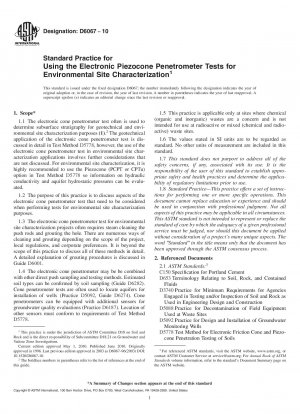ASTM D6067-10
Standard Practice for Using the Electronic Piezocone Penetrometer Tests for Environmental Site Characterization
- Standard No.
- ASTM D6067-10
- Release Date
- 2010
- Published By
- American Society for Testing and Materials (ASTM)
- Status
- Replace By
- ASTM D6067/D6067M-17
- Latest
- ASTM D6067/D6067M-17
- Scope
Environmental site characterization projects almost always require information regarding subsurface soil stratigraphy and hydraulic parameters related to ground water flow rate and direction. Soil stratigraphy often is determined by various drilling procedures and interpreting the data collected on borehole logs. The electronic piezocone penetrometer test is another means of determining soil stratigraphy that may be faster, less expensive, and provide greater resolution of the soil units than conventional drilling and sampling methods. For environmental site characterization applications, the electronic piezocone also has the additional advantage of not generating contaminated cuttings that may present other disposal problems (2, 3, 4, 5, 6, 7, 8, 15). Investigators may obtain soil samples from adjacent borings for correlation purposes, but prior information or experience in the same area may preclude the need for borings (1). Most cone penetrometer rigs are equipped with direct push soil samplers (Guide D6282) that can be used to confirm soil types.
The electronic piezocone penetration test is an in situ investigation method involving:
Pushing an electronically instrumented probe into the ground (see Fig. 1 for a diagram of a typical cone penetrometer). The position of the pore pressure element may vary but is typically located in the u2 position (Test Method D5778).
Recording force resistances, such as tip resistance, local friction, and pore water pressure.
Data interpretation.
The most common use of the interpreted data is stratigraphy based on soil behavior types. Several charts are available. A typical CPT soil behavior type classification chart is shown in Figs. 2 and 3 (9). The first step in determining the extent and motion of contaminants is to determine the subsurface stratigraphy. Since the contaminants will migrate with ground water flowing through the more permeable strata, it is impossible to characterize an environmental site without valid stratigraphy. Cone penetrometer data has been used as a stratigraphic tool for many years. The pore pressure channel of the cone can be used to determine the depth to the water table or to locate perched water zones.
Hydraulic conductivity can be estimated based on soil behavior type (Figs. 4 and 5). These estimates span two to three orders of magnitude. Alternately, pore pressure data (4.5) can be used for refined estimates of hydraulic conductivity.
When attempting to retrieve a soil gas or water sample, it is advantageous to know where the bearing zones (permeable zones) are located. Although soil gas and water can be retrieved from on-bearing zones such as clays, the length of time required usually makes it impractical. Soil gas and water samples can be retrieved much faster from permeable zones, such as sands. The cone penetrometer tip and friction data generally can identify and locate the bearing zones and nonbearing zones less than a foot thick very accurately.
The electronic cone penetrometer test is used in a variety of soil types. Lightweight equipment with reaction weights of less than 10 tons generally are limited to soils with relatively small grain sizes. Typical depths obtained are 20 to 40 m, but depths to over 70 m with heavier equipment weighing 20 tons or more are not uncommon. Since penetration is a direct result of vertical forces and does not include rotation or drilling, it cannot be utilized in rock or heavily cemented soils. Depth capabilities are a function of many factors including:
1.1 The electronic cone penetrometer test often is used to determine subsurface stratigr......
ASTM D6067-10 Referenced Document
- ASTM C150 Standard Specification for Portland Cement
- ASTM D3740 Standard Practice for Minimum Requirements for Agencies Engaged in the Testing and/or Inspection of Soil and Rock as Used in Engineering Design and Construction
- ASTM D5088 Standard Practice for Decontamination of Field Equipment Used at Nonradioactive Waste Sites
- ASTM D5092 Standard Practice for Design and Installation of Ground Water Monitoring Wells in Aquifers
- ASTM D5778 Standard Test Method for Performing Electronic Friction Cone and Piezocone Penetration Testing of Soils
- ASTM D6001 Standard Guide for Direct-Push Water Sampling for Geoenvironmental Investigations
- ASTM D6187 Standard Practice for Cone Penetrometer Technology Characterization of Petroleum Contaminated Sites with Nitrogen Laser-Induced Fluorescence
- ASTM D6274 Standard Guide for Conducting Borehole Geophysical Logging-Gamma
- ASTM D6282 Standard Guide for Direct Push Soil Sampling for Environmental Site Characterizations
- ASTM D653 Standard Terminology Relating to Soil, Rock, and Contained Fluids
ASTM D6067-10 history
- 2017 ASTM D6067/D6067M-17 Standard Practice for Using the Electronic Piezocone Penetrometer Tests for Environmental Site Characterization and Estimation of Hydraulic Conductivity
- 2010 ASTM D6067-10 Standard Practice for Using the Electronic Piezocone Penetrometer Tests for Environmental Site Characterization
- 1996 ASTM D6067-96(2003) Standard Guide for Using the Electronic Cone Penetrometer for Environmental Site Characterization
- 1996 ASTM D6067-96e1 Standard Guide for Using the Electronic Cone Penetrometer for Environmental Site Characterization
